TS Board Telangana SCERT Class 8 Physics Solutions 1st Lesson Force Textbook Questions and Answers.
TS 8th Class Physics 1st Lesson Questions and Answers – Force
I. Reflections on concepts
Question 1.
What is a force? What changes can be produced by a force?
Answer:
Force is a push or a pull. It Is an external cause which changes or tends to change the state of rest or motion.
- Force can change the shape of an object.
- Force can change the speed of motion.
- Force can change the direction of motion.
- Force can change the state of motion or rest.
Question 2.
Give two examples each for a contact force and a force at a distance.
Answer:
Contact force: Force is being applied by actually touching the body is called constant force
Eg:
- Muscular force
- Frictional force,
Noncontact force (or) Force at a distance: Force is being applied without touching the body is called non contact force or force at a distance.
Eg:
- Gravitational force,
- Magnetic force,
- Electrostatic force.
Question 3.
Explain Gravitational Force by giving a suitable example.
Answer:
Definition: The force exerted on a vertically projected body by earth is called gravitational force. Because of this force, only the body falls down to the ground.
Explanation:
- Every object on the earth or close to earth will experience a gravitational pull.
- This force of attraction exists between two bodies everywhere in the universe.
- Since earth is having more mass all the bodies which are close to the earth are attracted towards it.
- We cannot experience the gravitational force that exists between two persons and person with any table or blackboard because ills very small.
Eg:
- The force between teacher and student in the classroom.
- The force between student and blackboard.
- The force between Earth and Moon.
- The force between any two heavenly bodies.
Question 4.
Draw and explain a free-body diagram (FBD) to show all the forces acting on a car.
Answer:
Here Force F Applied by the Engine.
f = Frictional force applied by the road.
N1 and N2 ⇌ Normal forces
W → Weight of the car or Gravitational force.
The Net resultant force in vertical direction
Fnet = N1 + N2 – W
The Net resultant force along Horizontal force. N,
FNe = F-f
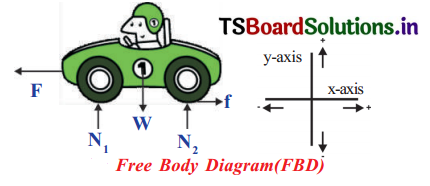
![]()
Question 5.
Why do tools meant for cutting always have sharp edges?
Answer:
The effect of force depends on the area of contact on which the force is acting. When there is a decrease in the area of contact of the force or load then the effect of force increases and vice versa. So the tools meant for cutting always have sharp edges to acquire maximum effect of force.
Application of concepts
Question 1.
How can you differentiate between a contact force and a force at a distance?
Answer:
| Contact force | Force at distance |
| 1. Force is being applied by actually touching the body Eg: Muscular force, Frictional force. |
1. Force is being applied without touching the body. Eg: Gravitational force, Magnetic force. |
Question 2.
Find the net forces from the following diagrams.

Answer:
a) Total force from left to right = 10 + 8 = 18 N
Force from right to left = 12 N
Net force = 18-12 = 6 N from left to right.
b) Force from left to right = 8 N
Force from right to left = 8 N
Net force = 8- 8 = 0 N
c) Total force from left to right 8 + 6 14 N
Force from right to left = 0 N
Net force = 14 – 0 = 14 N from left to right.
d) Force in upward direction = 9 N
Force in downward direction = 8 N
Net force = 9 – 8 = 1 N in upward direction.
Question 3.
A man stand still on a level floor. What forces will act on him? Draw a free-body diagram (FBD) to show all forces acting on him.
Answer:
Two forces acting on a man standing on a level floor.
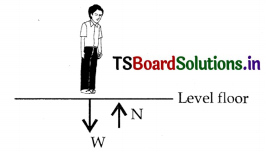
W – Weight (Gravitational force) 4, N Leri low
N- Normal force.
Question 4.
The surface area of an object is 20 m2 and a force of 10 N is applied on it then what is the pressure?
Answer:
Pressure = \(\frac{\text { Force }}{\text { Area }} \)
P = \(\frac{F}{A}\)
P = \(\frac{10}{20}\)
= \(\frac{1}{2}\) = 0.5 N/m2 or Pascal.
Question 5.
How do you appreciate the role of friction In facilitating our various activities?
Answer:
If there is no friction between any two surfaces in contact, then the present day civilization will be no more as we cannot even walk property on the ground. There will be no fabrics and garment, no construction of buildings and no future, even no fire for cooking and no vehicles. So friction is very necessary in our daily life. So, I appreciate the friction for its facilitation to us for doing various activities in our daily life.
Higher Order Thinking Questions
Question 1.
If you push a heavy box which is rest, you must exert some force to start its motion. However, once the box is sliding, you apply a lesser force to maintain that motion. Why?
Answer:
When a heavy box is at rest there is maximum frictional force between box and surface. So maximum force is used to move that box. Interlocking of irregularities in the two surfaces which are in contact cause friction force. When the box starts sliding, the static friction converts into sliding friction, which is less than static friction. So we need smaller force to maintain that motion.
Question 2.
Karthik Is observing the live telecast of a one-day cricket match. He noticed that motion of a roller on the pitch during lunch break. He thought about various forces acting on the roller and the net force when It is in motion. Many questions arose ¡n his mind regarding the direction of the net force. Can you guess what would be those questions?
Answer:
I think the following questions will be raised in his mind regarding the direction of the net force of the moving roller.
- Why does the roller move when it is pushed?
- What is the net force acting on the roller when it was pushed?
- What are the forces acting on the roller when it moves?
- Does the motion of the roller depend on the roughness and smoothness of the ground or not?
Question 3.
How do you increase the pressure by keeping (a) area unchanged and (b) force unchanged?
Answer:
We know that force acting on a unit area of a surface is called pressure.
Pressure = \(\frac{\text { Force }}{\text { Area }}\)
I will change the pressure by keeping —
area unchanged: If force acting on the same area of surface, the pressure also increases. So we can change the pressure by changing the force acting on that surface.
Pressure ∝ Force.
force unchanged: By increasing or decreasing the contact area or surface area on which the force is acting, there will be change in pressure acting on it without changing the force.
If the surface area is smaller the pressure will be greater and vice versa.
Pressure ∝ \( \frac{1}{\text { Area }}\)
![]()
Question 4.
Imagine that friction disappeared from the earth. What will happen? Explain.
Answer:
If the friction has disappeared from the earth.
- We will not be able to walk or run on the ground.
- Vehicles will not move if they are in rest. Vehicles will not stop if they are in motion.
- We will not be able to hold the things.
- Accidents will occur if there is no friction.
- Without friction, no building could be constructed.
Multiple Choice Questions
Question 1.
Hoisting a flag is related to ( )
A) push
B) pull
C) Push and pull both
D) pressure
Answer:
B) pull
Question 2.
A person is pulling water from well. Which type of force it is ( )
A) Muscular force
B) Magnetic force
C) Friction force
D) Electrostatic force
Answer:
A) Muscular force
Question 3.
The force that a solid surface exerts on any object in the normal direction is called ( )
A) Muscular force
B) Normal Force
C) Tension force
D) Magnetic force
Answer:
B) Normal Force
Question 4.
let the forces F1 and F2 act on the table in opposite directions F1 > F2, the Fnet = ( )
A) F1 – F2
B) F1+F2
C) 0
D) 2F2 – F1
Answer:
A) F1 – F2
Question 5.
A situation for effect of force leads to a permanent change in shape of object is ( )
A) Stretching Rubber band
B) Squeezing sponge
C) Spring
D) Breaking glass
Answer:
D) Breaking glass
Suggested Experiments:
Question 1.
Conduct an experiment to find the limiting forces that can be borne by different strings.
Answer:
Aim: To find the limiting force that can be borne by a string.
Material used: Spring balance, weights, light strings, weight hanger.

Procedure:
- A spring balance is suspend from rigid support.
- To it a weight hanger is connected.
- Slowly increase the weights in the weight hanger in steps of 50 grams and note the readings of spring balance.
- Repeat this experiment till the string breaks.
- Repeat the experiments with various strings and find out the limiting force of each wire.
Question 2.
Design and conduct an experiment to test few ways how Friction may be reduced.
Answer:
- Take a thick – heavy book. Push it on the surface of a table. You observe that book moves slowly with the force and covers a small distance.
- Now take three pencils. Place them parallel to one another on the table and place the book over them.
- Push the book again with the same force. The book moves a larger distance over the rolling pencils. Rolling pencils reduce the friction.
- In this way we can reduce the friction by using rollers.

Question 3.
Conduct an experiment to determine the change in effect of force with an area of contact.
Answer:
- We know pressure = Force/Area and Its ST unit is N/ met2 (or) Pascal.
- Take a pencil. and push its rounded end on %roUr palm.
- Now push from the other side of the pencil gently so that sharp end is on your palm.
- We notice that the effect of force depends on the area of contact on which force is acting.
- When there is decrease in area of contact force, or load then the effect of force Increases and vice versa.
- ln case of porters keeping luggage on Turbance, School bags straps have more width are some more examples where the force depends on area of contact.
Suggested Projects
Question 1.
Collect pictures to illustrate contact forces, force at a distance and prepare a report.
Answer:
Contact forces:

Forces at a distance:

Question 2.
Classify the actions In your daily life into
i) actions where we exert force which appears as a push
ii) actions where we exert force which appears as a pull
iii) actions which involve both push and pull
Answer:
i) Pushing a heavy ooden table.
ii) Hoisting a Flag
iii) Erasing Blackboard with duster.
![]()
Question 3.
Observe the situations of electrostatic forces in your daily life and prepare a report.
Answer:
- When we keep our hand, near TV monitors, when TV is playing the hairs odour hand are attracted towards the monitors.
- When glass rod is rubbed with silk cloth glass rod get positive charge and silk gets negative charge.
TS 8th Class Physics 1st Lesson Force Intext Questions
Think and discuss
Question 1.
A book placed on a table is at rest. Is the force of friction acting on it or not? Explain.
Answer:
When the book is at rest, there is no frictional force acts on it, because frictional force comes to play when we try to move it. But a normal force acting on book acts in upward direction by the table.
Question 2.
A system of two bodies A and B are placed as shown in figure. How many forces are acting on A and B respectively?
Answer:
The forces acting on A:
- Gravitational force (Downward direction)
- Weight of B (Downward direction)
- Normal force by floor (Upward).
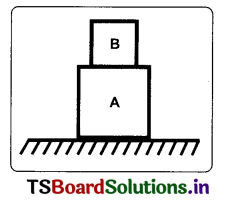
The forces acting on B:
- Gravitational force (Downward)
- Normal force by A (Upward direction)
- Normal force by floor (Upward)
Question 3.
Why it is necessary to separate a contact force into a normal force and a frictional force? Give at least two reasons.
Answer:
It is very useful to separate a contact force into a normal force and a frictional force. It is useful to calculate the net force acting on the body. To calculate the minimum force required to move a body.
Eg: If a body is at rest means normal force and frictional force are equal and opposite. You have to use force which is more than the frictional force, If it is frictional force, N is normal force and F is the applied force.
Fnet = F = f (X-axis direction)
Fnet = N = w (Y-axis direction)
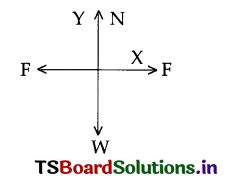
Question 4.
A cricket ball of mass ‘m’ is thrown upward with some initial speed. If the air resistance Is neglected, what forces are acting on the ball when it reaches
(a) half of its maximum height and
(b) Its maximum height?
Answer:
a) When the ball reaches half of its maximum height three forces acting on it.
- Force of push acting upward.
- Friction force by air surrounding the ball.
b) When the ball reaches its maximum height two forces acting on it. Normal force or frictional force by air.
Question 5.
two Identical bars, in which one is steel and the other Is a magnet, are painted with same colour. How can you tell which one Is magnet by using only these two bars?(don’t break the bars)
Answer:
If you freely suspend the bars, the magnets come to rest in North-South direction. The steel bar comes to rest in any direction. In this way we can identify the magnet.
Question 6.
Play arm wrestling with your friend. How can you explain the winning of the game by using the concept of net force? Name forces acting on arm and their direction while playing the game. Try to draw FBD for this situation. What forces can do?
Answer:
We know that if two forces act in opposite directions the net force is equal to the difference between the two force. In arm wrestling game, if the two opponents apply same force none of them can move out of the ring.
If one of the opponent’s forces is more than the second one, second person moves out from the ring, then the first person is the winner. If first person is thrown out from the ring by second person, then the second person is the winner. Here the net force acts in the direction of the force applied by the winner.
Question 7.
Does pressure have direction? Explain.
Answer:
Pressure has both magnitude and direction.
Pressure = \(\frac{\text { Force }}{\text { Area }} \)
Since force has direction, pressure also has direction.

TS 8th Class Physics 1st Lesson Force Activities
Activity – 1:
Identiing Dush or pull: (Text. P. No. 1)
Question 1.
“Observe the following table and identify the actions involving push or pull or both. (Conceptual understanding/Information Skills)
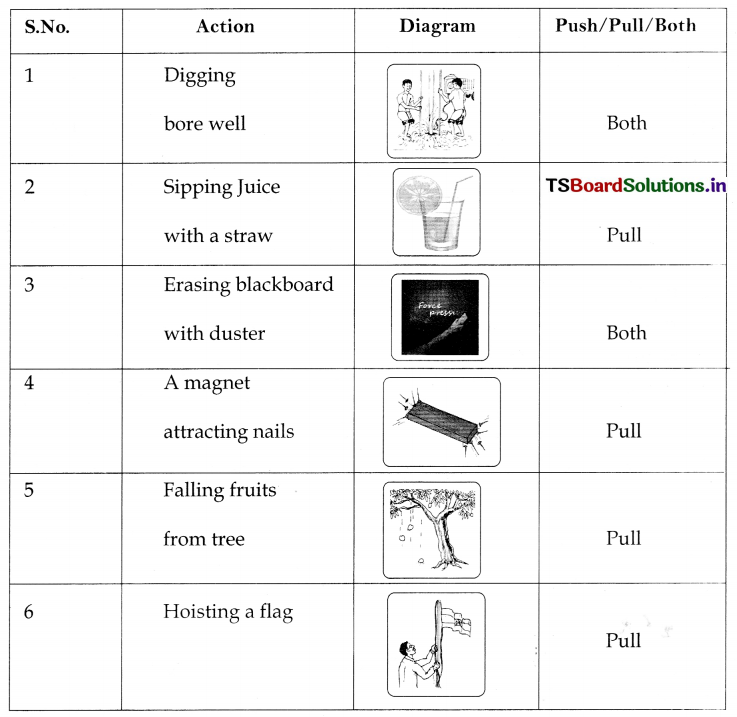
a) List three more activities where we exert force which appears as a push. (Conceptual understanding)
Answer:
1. To move the car which is at rest we apply force which appears as a push from back side of the car.
2. We push the table to move front.
3. To close the door we use push as a force.
b) List three more activities where we exert force as a pull. (Conceptual understanding)
Answer:
1. To lift the water from well we use pull as force.
2. To open the door we use pull as a force,
3. We pull the thread of the bow to release an arrow.
c) State three actions which involve both push and pull. (Conceptual understanding)
Answer:
1. To make chapati we use both pull and push on rolling pin.
2. We use both push md pull in ironing the clothes.
![]()
Activity -2:
Preparing a list of examples for muscular force: (Text P.No.3)
Question 2.
List at least ten activities where we apply muscular force to perform various tasks. (Information skills and Projects)
| Activity where we apply muscular force |
| 1. Lowering a basket |
| 2. Brushing |
| 3. Bathing |
| 4. Eating |
| 5. Driving |
| 6. Walking |
| 7. Lifting the school bag |
| 8. Writing |
| 9. Cutting vegetables |
| 10. Playing |
a. Do you feel your muscles get tightened while performing any physical activity? What could be the reason for it?
Answer:
The muscles which are at backside of shoulder will contract if we throw an object to front. In the same way when we lift an object then also our muscles contracted. If we stress a smooth ball with our palms then also muscles tightened it.
Activity -3:
Observing the changes in any muscle while working:
Question 3.
Discuss an activity to observe the changes in any muscle while working. (Experimentation/Application to daily life)
Answer:
Muscles are normally arranged in opposition so that as one group of muscles contract or shortens, another group relaxes or lengthens. For example if you throw a ball the muscles in the chest and front of the shoulder contract to pull the arm forward, while the muscles in the back and rear of the shoulder also undergo contraction to slow the motion down to avoid injury. This shows that our muscles undergo some changes while working.
a) Why does the ball stop?
Answer:
The frictional (once between ball and floor opposes the motion of the ball. That is why ball stops after traveling some distance.
b) Is there any hidden force which brings it to stop?
Answer:
Yes, frictional force helps the ball to stop.
c) Why does the speed of bicycle decrease gradually? (Application to daily life, concern to biodiversity)
Answer:
The speed of bicycle decreases gradually because there is frictional force between lyres and road which opposes the motion of the bicycle.
d) Is there any force acting on It which tends to slow down its speed?
Answer:
Yes, there is frictional force on it which tends to slow down its speed
Activity -4: Observing the motion of a ball on different surfaces:
Question 4.
Roll a ball on different surfaces and observe the motion of ball discuss your observation. (Field investigation/ Experimentation/Making hypothesis)
Answer:
Take a ball. Try to roll the ball on different surfaces like carpet, rough roads, smooth floor etc. The motion of the ball is different on different surfaces. The force offering resistance seems to be more on the rough surfaces than on the smooth surfaces. From this we conclude that fractious force depends on the nature of surfaces which are in contact.
a) If we roll a ball on different surfaces like carpet, rough, roads, smooth or etc then on which surface ball rolls farther?
Answer:
Bail travells more distance on smoother surfaces. The frictional force which opposes the motion of the body is less on smoother surface.
Activity-5 :
Observing the motion of objects in an inclined Diane
Question 5.
Write your observation while moving different objects move on inclined planes. (Experimentation)
Answer:
- Take a tray. Place a small ice cube, eraser, and a rupee coin to stay in line on one end of the tray.
- Now slowly lift this end of the tray as shown in the figure. It forms an inclined plane.
- If you observe, ice cube moves lastly on the inclined plane, then one rupee coin, and finally eraser, move slowly.
- From the above experiment, we conclude that the force of friction is different for different substances while they are moving on the same inclined plane.
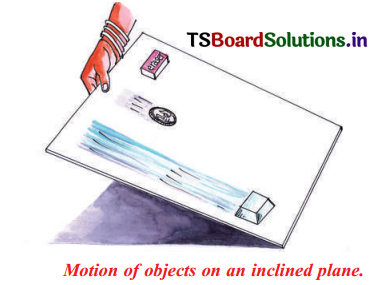
Activity -6:
Observing the magnetic force:
Question 6.
How do you prove that like poles repel and unlike poles attract each other? Which type of force is magnetic force? (Experimentation/Making hypothesis)
Answer:
- Take a sewing needle. Rub it with a bar magnet several times always moving the magnet in the same direction. After some time the needle acts like a magnet.
- With the help of a magnetic compass, you can identify the north and south poles of the needle.
- Pin a red-colored foam ball to the south pole and white ball to north pole of the needle; then drop it in a bowl of water it floats.
- Make another needle in the same way. Float both of them side by side facing the like ends.
- You observe they repel each other.
- Float them side by side facing the unlike ends. You observe they attract each other.
- From the above experiment, we conclude that Like poles repel and unlike poles attract each other.
- This action of pull or push results due to a magnetic force.
- Here magnet can attract or repel another magnet without any contact with the second magnet. So magnetic force is a non-contact force.
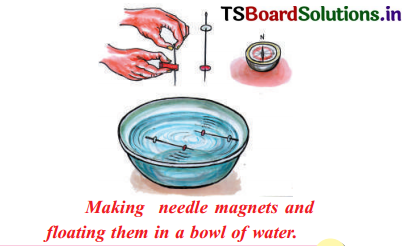
Activity – 7:
Observing electrostatic forces
Question 7.
Conduct an experiment/activity to observe the electrostatic forces? (Experimentation)
Answer:
- Take a balloon. Inflate it and tie tip the open end.
- Cut a paper into small pieces and place them on the
- balloon with a paper and bring the balloon near to pieces of paper.
- You observe paper pieces are attracted by the balloon.
- When the balloon is rubbed with a paper it acquires an electrostatic charge on its surface.
- The balloon is now said to be a charged body. When it is brought nearer to the pieces of paper. they acquire opposite charge and attracted b the balloon.
- The force exerted by a charged body on another charged or uncharged body is known as electrostatic force.
- This force comes into play even when the bodies are not in contact. So electrostatic force is an example for the force at a distance.

Activity 8:
Visualizing magnetic field:
Question 8.
How do you visualize the magnetic field using a bar magnet and iron filings? (Experimentation)
Answer:
- Take a bar magnet and place it on a table, Place a thin white paper over it.
- Sprinkle the fine powder of iron (iron filings) on the paper. Tap the table or paper gently.
- You observe a pattern of iron filing around the bar magnet.
- Rotate the magnet in different directions and do the same. In every case pattern of iron filing around the bar magnet is formed.
- Iron filings set themselves in a pattern because they are affected by the magnetic force of the field created by thE bar magnet.
- Thus, the space around the magnet where its influence can be detected is called the ‘magnetic field’.
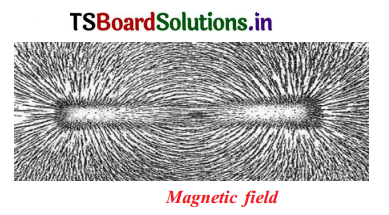
Activity- 9:
Effects of net force acting on a table:
Question 9.
Explain an activity to know the effect of different forces on net force acting on an object (Experimentation/Field investigation)
Answer:
- Take a heavy table which you can move only by pushing hard.
- Try to push it all by yourself. If the table do not move, then ask your friend to help in pushing it in the same direction. Now the table moves in the direction of force.
- Here net force acting on the table is equal to the sum of forces Since they act in the same direction.
- Now push the same table, but ask your friend to push it from the opposite side. The table doesn’t move if you both apply equal forces. Net force acting on the table is zero.
- When forces act on a body only in straight line are in s.me directions, the net force is the sum of all forces acting on the body. Fnet = F1 + F2
- When forces act on a body in a straight liiw are in opposite directions, the net force is equal to difference between the two forces.
Fnet = F1 + (- F2) = F1 – F2.

Activity – 10;
Effects of stretched rubber bands on fingers:
Question 10.
Effects of stretched rubber bands on fingers. Show that the net force will act if there are more than one force is acting on the same object.
Answer:
- Take a rubber band, stretch it using your fingers.
- When you stretch the rubber band it exerts force on your fingers and you feel the force of pull on your finger.
- Add another rubber hand around your fingers and stretch both together to the same length.
- We feel by increase the number of rubber bands around our fingers and the force exert on our fingers is more.
- Rubber band has F units and the force exerted by the second rubber band is F units. Then the net force of two rubber bands is Fnet = F + F = 2F units

![]()
Activity – 11 :
Effect of force on change of the state of motion of an object and its direction.
Question 11.
Explain with an activity how the force affects the change of the state of motion of an object and its direction. (Experimentation)
Answer:
- Place a football on the ground. The ball will remain there in the state of rest unless someone kicks the ball.
- Kick the ball, it starts moving, kick the moving ball in the same direction, the speed of the bail increases.
- Place your hand or leg against the ball, then the hail may be stopped or may be changed its direction of motion.
- From this we conclude that the (orce changes the direction of motion and state of the body.
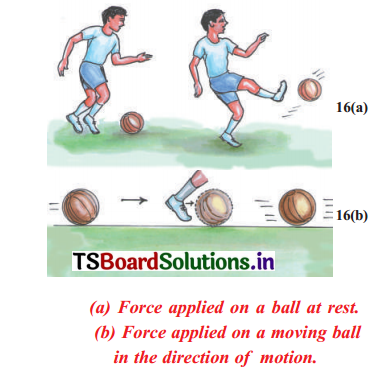
Activity-12:
Effects of net force on direction of moving object
Question 12.
Conduct an activity to show the effects of net force on direction of moving object.
Answer:
- Hit a carom coin with the striker.
- We can observe that in each case the direction of the coin changes.
- We hit the coin with the striker not only the coin changes its direction, but also the strikes changes its direction too.
- From this we can say that the net force stops a moving or makes a stationary object move and also changes the speed and direction of a moving object.

Activity – 13:
Effects of force on the shape of an object:
Question 13.
In the table given below, some situations are given. Complete the table and write your conclusion. – (Project work/Making hypothesis)
Answer:
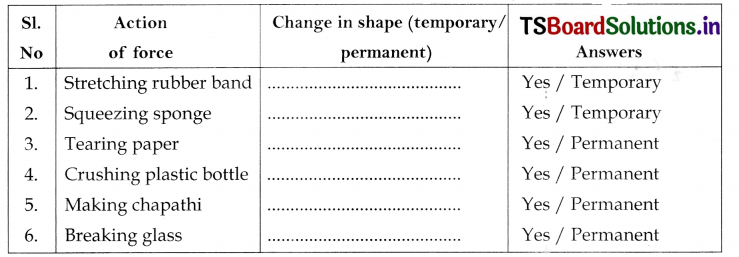
From the above table we can understand that the force not only changes the state of motion of an object but also the shape of an object. It may change the shape temporarily or permanently, which is based on the nature of the object and the force applied on it.
Activity – 14 :
Chance in effect of force with area of contact:
Question 14.
How the effect of force changes with area of contact. (Experimentation/Field investigation)
Answer:
i. Take a pencil. Just push its rounded end on ‘our palm. There is less pain because less force acts on your palm.
ii. Now push from the other side of the pencil so that the sharp end is on your palm. Then you feel pain because more force is acting on your palm.
iii. From this you might have noticed that effect of force depends on area of contact on which the force is acting.
iv When there is a decrease in the area of contact of the force, then the effect of force increases and vice versa.
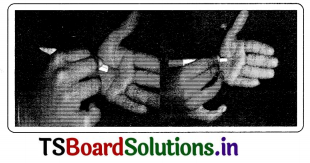
a) What is pressure? Write the units of pressure? (Conceptual understanding)
Answer:
The force acting on a unit area of a surface is called pressure.
Pressure- Force / Area.
SI. unit of pressure is Newton/meter2 or N/m2.
CCS unit of pressure is Dyne / cm2.
Activity – 15:
Identifying effects of force:
Question 15.
How can you say that the contact area on which force is acting changes the effect of force? (Experimentation/Field investigation)
Answer:
- Take two trays and fill trays with lime powder.
- Take two rectangular bricks of equal mass and similar shape.
- Keep one brick vertically in one tray and the other brick horizontally in another tray.
- You may notice that the brick standing vertically sinks deeper in lime powder than the brick standing horizontally.
- Since the masses are same, the force applied on lime powder by them also same on both the trays.
- The difference lies in the surface area of the brick in contact with the lime powder, and this is responsible for the brick sinks in the lime powder.
- From the above we can see that for a given force if the surface area is smaller, the pressure will be greater.
- If we use larger area, we are spreading out the force, and the pressure becomes smaller.

![]()
Lab Activity
How do you find the Ìimiting force that can be borne by a string?
Answer:
Aim: To find the limiting force that can be borne by a string.
The material used: Spring balance, weights, light strings, weight hanger.
Procedure:
- A spring balance is suspend from rigid support.
- To it a weight hanger is connected.
- Slowly increase the weights in the weight hanger in steps of 50 grams and note the readings of spring balance.
- Repeat this experiment till the string breaks.
- Repeat the experiments with various strings and find out the limiting force of each wire.

a) What do you observe from the readings when it is pulled up and released to
move down?
Answer:
When it is pulled up the reading of spring balance increases that means apparent weight of the object increased.
b) Is the string broken when the whole system is pulled quickly up?
Answer:
If the whole system is pulled quickly up, the string may be broken.